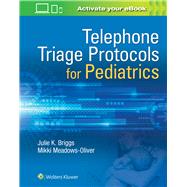- ISBN: 9781496363602 | 1496363604
- Cover: Spiral Bound
- Copyright: 9/21/2017
Handle questions about pediatric care with confident accuracy: Telephone Triage Protocols for Pediatrics is the quick-access guide to providing fast, efficient phone assessments and accurate care recommendations.
This comprehensive, on-the-spot resource lists a broad range of symptoms alphabetically. A flow chart format provides the crucial Yes or No questions to ask, with each answer moving quickly to optimal recommendations or instructions. A vital resource for all nurses, this is irreplaceable to those in pediatric or family practice.
Tap into top-level guidance for fast, efficient assessments …
Must-have resource for medical offices, clinics, schools, emergency departments, urgent care centers, home health agencies, and managed healthcare providers
About The Authors
Julie Briggs, RN, BSN, MHA, is Director of the Emergency Department at Good Samaritan Community Healthcare in Puyallup, Washington.
Mikki Meadows-Oliver, PhD, RN, PNP-BC, is an Associate Professor at the Yale University School of Nursing in Orange, Connecticut.
This comprehensive, on-the-spot resource lists a broad range of symptoms alphabetically. A flow chart format provides the crucial Yes or No questions to ask, with each answer moving quickly to optimal recommendations or instructions. A vital resource for all nurses, this is irreplaceable to those in pediatric or family practice.
Tap into top-level guidance for fast, efficient assessments …
- Step-by-step guidance for making accurate assessments —170 proven protocols addressing a wide range of symptoms, disorders, and medical emergencies, for newborn to age 18
- Sorts life-threatening problems from those not requiring physician or emergency care—callers are directed to make an appointment, seek emergency care, or follow home care instructions
- Increases consistency of advice and documentation
- Supports nurses of all knowledge and experience levels
- Color tabs for each section enable quick access
- Symptoms alpha-organized and grouped by level of urgency, addressing injuries, trauma, pain, swelling, and other symptoms for:
- Head, eyes, ears, nose, throat, mouth, back, neck, arm, and leg
- Body system problems – chest/cardiovascular, respiratory GI, genital/obstetrics and gynecological problems, urination, and skin problems
- Chronic and infectious diseases
- Behavioral problems
- Infant-specific problems
- Key Questions to ask the caller
- Other Protocols to Consider Reminders – for proper documentation
- Assessment – symptoms and conditions that determine urgency
- Action column – Following Yes or No answers to assessment questions, with emergency actions appearing first
- Immediate actions – proven protocols and/or referrals to emergency, physician, or at-home care
- Home Care Instructions – before emergency care, before appointment, or at-home care
- Emergency Instructions – in-the-moment first aid
- Report the Following Problems – what caller should tell their physician or emergency department
- Seek Emergency Care Immediately – if certain symptoms occur
Must-have resource for medical offices, clinics, schools, emergency departments, urgent care centers, home health agencies, and managed healthcare providers
About The Authors
Julie Briggs, RN, BSN, MHA, is Director of the Emergency Department at Good Samaritan Community Healthcare in Puyallup, Washington.
Mikki Meadows-Oliver, PhD, RN, PNP-BC, is an Associate Professor at the Yale University School of Nursing in Orange, Connecticut.







